Jan 24, 2024
Colonial Solar House Update
Author Scott Willenbrock details how retirement, sending a daughter off to college, getting a Tesla Model 3, and surviving a pandemic have all affected his home's energy use.
By: Scott Willenbrock
Colonial Solar House celebrated its 10th anniversary in 2023, so it seems like a good time to provide an update on its performance. Since the first report (Spring 2020) I have retired, sent my daughter off to college, replaced the Chevy Volt with a Tesla Model 3, and survived a pandemic—all of which have changed our energy usage to some extent. The only upgrade to the home’s energy system has been the addition of battery storage, so let me start there.
Tesla Powerwall Batteries
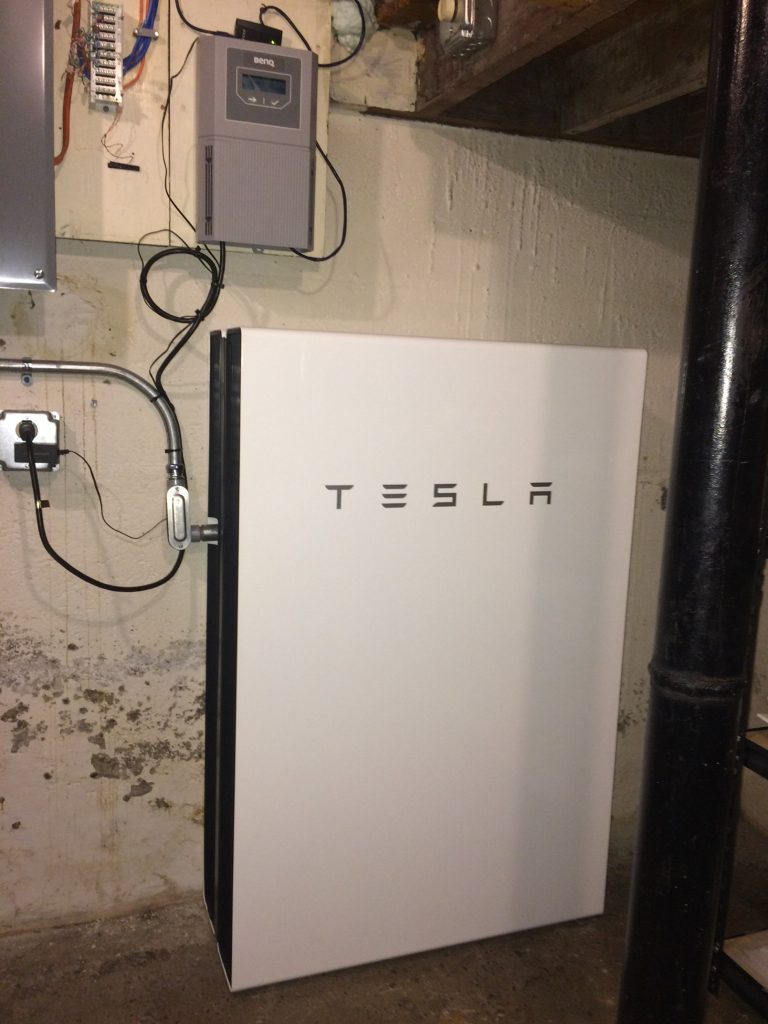
What does a physics professor get for a retirement present? Two Tesla Powerwall 2 batteries, able to store a total of 27 kWh of energy, paid for in part by a 30% Federal Tax Credit. Each battery has a maximum continuous charging rate of 5 kW, so two batteries can almost accommodate the peak power of the solar array, which is observed to be 12 kW. The batteries were installed in 2020 by Solar Energy Solutions. When there is a power outage, the system instantaneously disconnects from the grid and is powered by the batteries and/or the solar array. We have had seven such outages over the past three years, for a total of six hours of power interruption. The transition works seamlessly; I only knew of the power outages because my Tesla app alerted me to them. Without the batteries, the solar array would stop producing power during a power outage. In the (hopefully unlikely) event of an extended power outage, we could survive indefinitely off-grid in the summer and the milder months of the spring and fall. A power outage in the winter would be much more challenging, both because of the large heating requirement and the reduced solar exposure. Since the batteries provide backup power for the entire house, we have the flexibility to pick and choose which devices we want to power during an outage.
The Tesla Powerwall batteries are designed to be installed on a system with a maximum current of 200 Amp, so we had to replace my 400 Amp main breaker with a 200 Amp breaker. I had previously tested the peak power demand of my home by turning on every electric device, including the charging of the two electric cars, at full load. It was less than 200 Amp, so I am confident that I will never experience a shortage of power from the reduction in the main breaker size.
The 27-kWh total capacity of the two batteries is small compared with the capacity of our Tesla Model X (85 kWh) and Model 3 (80 kWh). It would be ideal to be able to use our car batteries to back up our house (so-called Vehicle to Home mode), but this is not available with the current generation of Teslas.
I considered whether it would make sense financially to store solar energy during the day and use it during the peak morning and evening periods if we were on a time-of-use pricing plan. I estimated that I would indeed save money, but not nearly enough to justify this strategy. Cycling the battery contributes to its deterioration, and the cost of the battery is so high that it dwarfs the savings from storing solar energy and using it later. Therefore, we only use the battery as a backup, and keep it fully charged at all times.
I tried a time-of-use pricing plan (Ameren Illinois Power Smart Pricing) for one year but was disappointed with the results. In theory, it should be advantageous: I am compensated at a relatively high rate for the solar electricity I export during the day, and I charge my two electric vehicles at a relatively low rate at night. In practice, there are two effects that more than negate these advantages. One is that electricity prices can become very high during very cold weather (when natural gas supplies are strained), and this is exactly when I need to buy the most electricity for heating.
The other is the way the transmission charge is calculated. With straight net metering, the transmission charge is calculated based on the net use of electricity, just like all the other charges. That means you receive credit during any month in which your net use of electricity is negative. With time-of-use pricing, the transmission charge is calculated based on your use of electricity during the grid peak hour each month, and never goes below zero. That means you are not being compensated if you are exporting electricity during the grid peak hour, which is patently unfair. It also means that you may have a significant transmission charge even if your net use of electricity is very low during the month. In the final analysis, I found that I paid slightly more on a time-of-use plan than I would have paid with straight net metering.
Solar Photovoltaic System
I mentioned in my first report my fear that squirrels would acquire a taste for electrical wiring. One day a neighbor sent me a photo of a raccoon on the peak of our roof, and another neighbor told us of a similar sighting not long after that. I decided it was time to install a pest barrier around the solar array. Since the array on my roof is pretty complicated, this was not straightforward. I hired New Prairie Solar to do the work, the solar division of the company that had installed the array back in 2013. They did a terrific job. The array on the roof of my garage and sheds is way too complicated to install a pest barrier, so I am just keeping my fingers crossed.
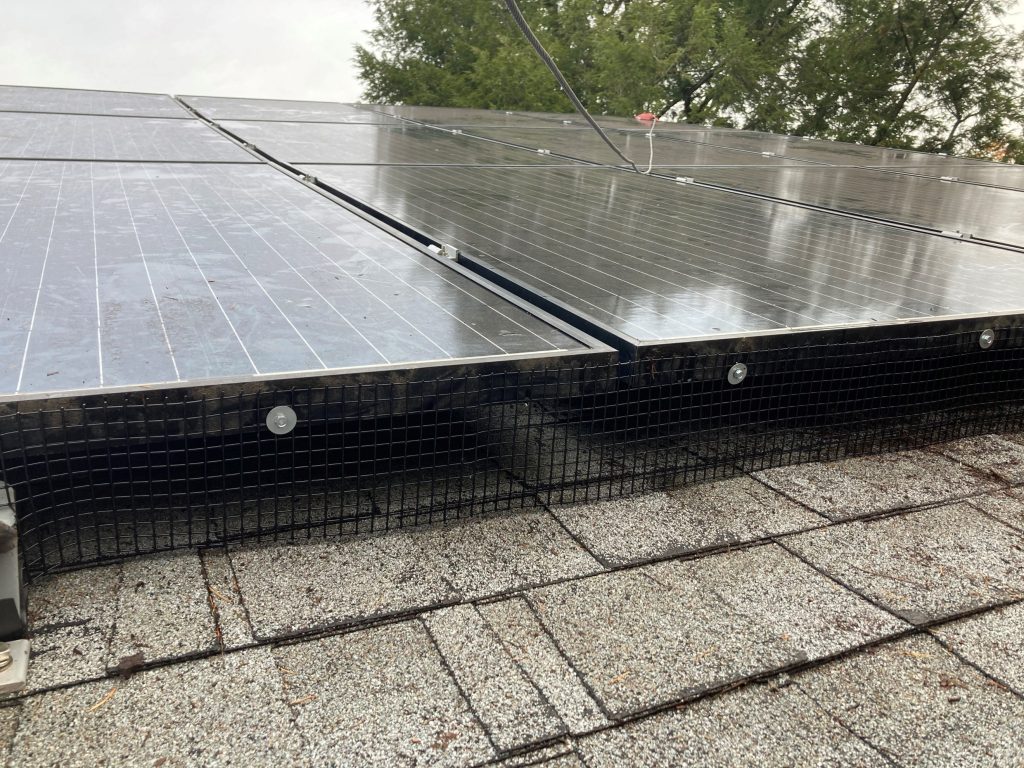
One day we noticed a crack in the wall in an upstairs bedroom, in a corner near the ceiling. It was traced back to a leak in our attic, somewhere under our solar array. We had New Prairie investigate, but they did not find any leaks at the roof penetrations. We decided to remove 15 solar modules and have the roof repaired in that area. When they came to remove the modules, they discovered that a raccoon was living under the array, despite the pest barrier. A pest barrier is a joke to a raccoon; I later learned that they can tear through the shingles and decking of a roof to gain access to an attic. We had the raccoon removed by Steve Beckman of Anything Wild, and the 15 modules removed after that. To my dismay, we discovered a roof underneath that was beyond repair.
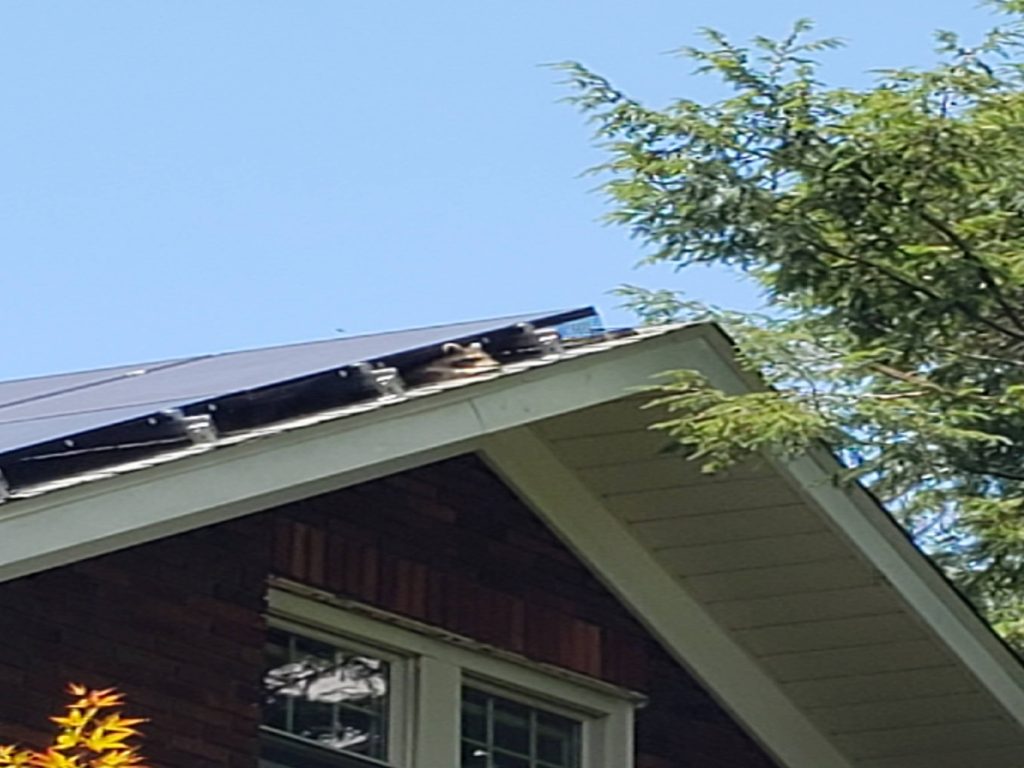
I called my insurance company, Amica, and they sent an adjuster to examine the damage. He acknowledged the damage from the raccoon, but also found that the north side of the roof had hail damage, something I was totally unaware of. The decision was made to remove the solar array and replace the entire roof. The garage roof did not have any damage, so it was left alone. Amica paid for the cost of the project, minus my deductible. In the 26 years I had owned my home, this was my first insurance claim.
The new roof was expertly installed by White Roofing, after which New Prairie reinstalled the solar array. I had commented in my first report that I disliked my mounting system, which involves long horizontal rails that make great places for squirrels to build nests. An alternative mounting system that my neighbor has does not use any rails, but it requires the modules to be mounted in landscape mode, while mine are mounted in portrait mode. We decided to stick with our existing mounting system, and instead concentrate on keeping squirrels (and raccoons) off the roof in the first place. I had an open pit compost pile in the backyard that was great at attracting animals, so I replaced that with a covered plastic compost bin. We had a large hemlock tree trimmed back so it no longer made an ideal bridge to access our roof. Steve Beckman told me that raccoons can climb downspouts to access a roof, so we had guards installed on our four downspouts. I hope these deterrents will be enough to keep squirrels and raccoons off the roof of our house. The garage and sheds are impossible to secure, so I just hope for the best.
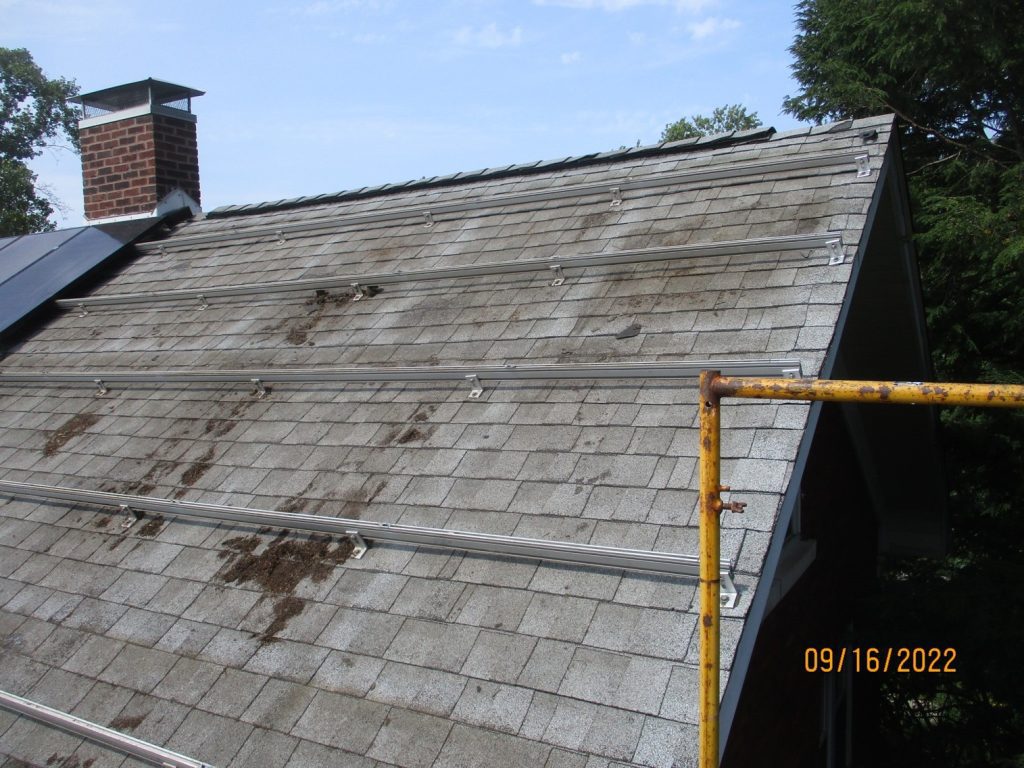
When we first installed the solar array back in 2013, we were careful to make sure that every roof penetration went into a rafter. This is no longer considered necessary by New Prairie; they just mounted everything onto the decking, which makes the installation significantly easier. They also used a different mount than the L feet I originally used. The common denominator is the Flexible Seal under the mounts, which seems to be a great product for sealing the roof penetrations.
Several years ago, our solar monitoring system stopped working consistently. I made a concerted effort to reboot it in 2020 but gave up in frustration. Then in 2023 it suddenly started working again, for no apparent reason. I discovered that 5 of my 69 modules were not reporting any power production, but I couldn’t tell if that was because they were truly not producing power, or if the powerline communication was not working. It occurred to me that my garage, which faces due south, should report identical power production off the east and west facing roofs at the meridian (11:45 AM in Champaign, IL) if all of the modules were working (eight on each roof). Using an ammeter, I found that the west roof was producing less power than the east roof, so I knew that there was truly a power production issue.
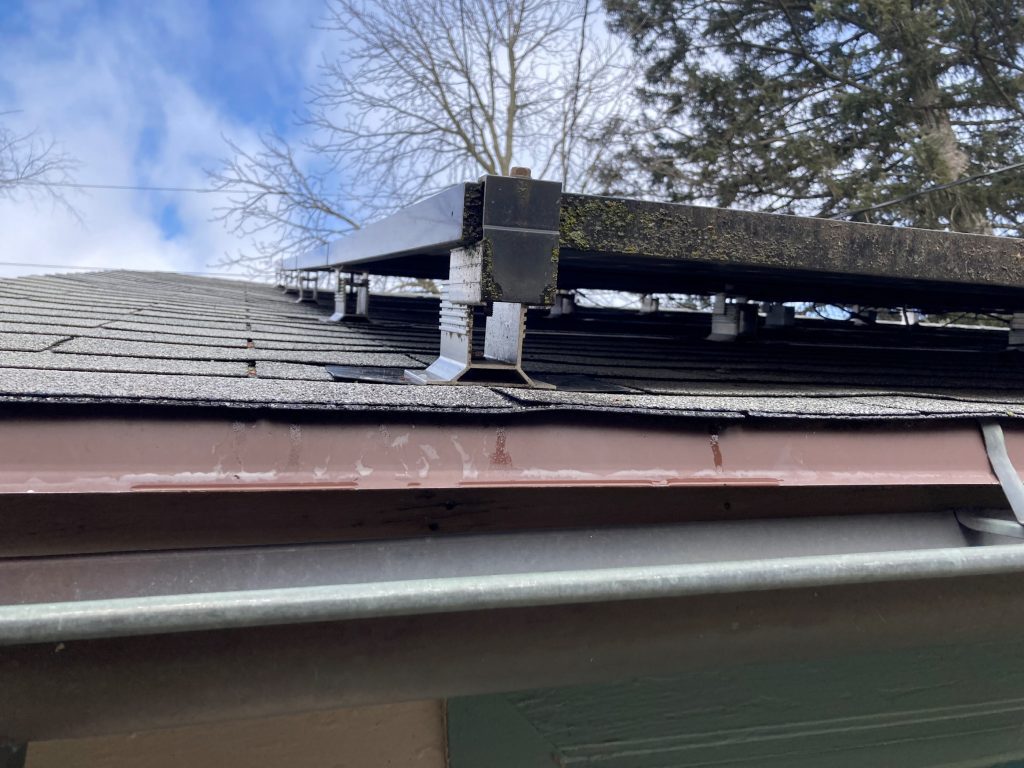
The first step was to replace the microinverters on three modules on the garage (one each on the East, West, and South roofs). Recall from my first report that my microinverters were made by SolarBridge, which was ultimately absorbed by Enphase. Fortunately, my colleague Phil Krein, the cofounder of SolarBridge, had five microinverters in storage that he leant me. I hired New Prairie to replace the three microinverters on the garage. They found that one of them had a squirrel’s nest underneath it, and that the wiring had been chewed. After the replacements, that particular module began reporting power production, but the other two did not. That module is on the west face, and after the replacement I found that the power production on the east and west faces is identical at the meridian. I am not sure what to make of this, as the compromised module on the east face is still reporting no power production. This is an ongoing project, as I would ideally like to have all my modules producing power and reporting to the monitoring system.
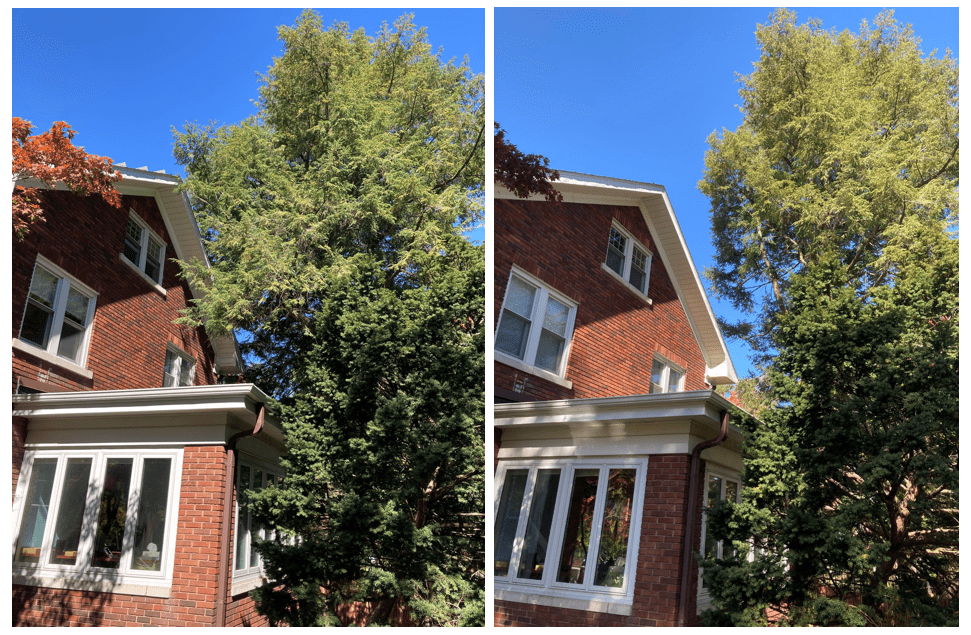
The glass on one of my modules is cracked radially from a central hole, as if a heavy object fell on it. I put clear tape over the hole. The module has shown no sign of reduced power production thus far.
One of the benefits of having installed the two Tesla batteries is the accompanying Gateway that manages power flow from the solar array to the batteries, the house, and the grid. This gives me a reliable way to measure my power production independent of my monitoring system. For example, on December 24, 2023, the peak power reported by the Gateway was 6.1 kW, while the monitoring system reported only 5.5 kW. This suggests that there are modules that are producing power but not reporting it, which makes troubleshooting challenging.
I have never felt it necessary to clean my modules, as the occasional drenching rain we receive in central Illinois seems to do the job well enough. To test this, I chose two modules right next to each other that were reporting identical power production, and used a hose to clean one of the modules. I did not use any soap, as I have heard that it can leave a film on the glass. Cleaning the module this way made absolutely no difference in its power production, so it is a waste of time and effort. I also don’t bother with snow removal anymore as we haven’t gotten enough snow in the past few years to justify the effort.
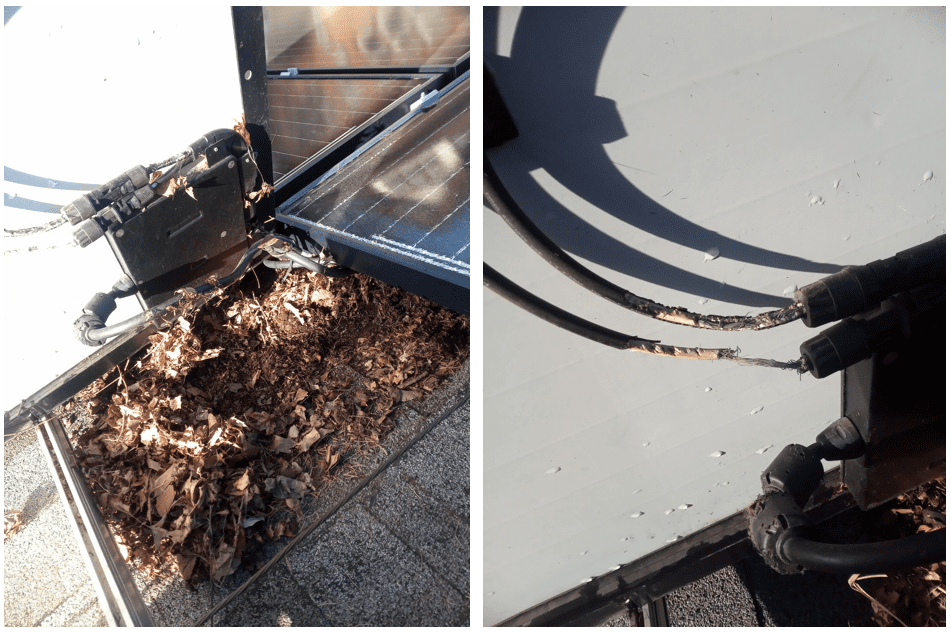
Geothermal Heating and Cooling
Our Waterfurnace 7 Series heat pump continues to work well. In the 10 years we have had it, we have had to replace two electronic control boards and replace the blower motor twice—twice the second time being recent and within a year of the first, so it was under warranty. We have also had to replace five damper motors.
The recent loss of the blower motor meant we were without heat for two days in the winter. The house performed well, in part because the coldest temperature during those days was 36 °F and there was a good amount of solar thermal heating during the day. The first floor only got as cold as 62 °F and the second floor 68 °F. Adding small resistance heaters to a couple of rooms kept everyone comfortable.
Appliances
LED lights are amazing. Of the 75 LED lights I have in my house, I may have replaced one or two in the past 10 years.
The GE heat pump water heater has worked flawlessly for more than 10 years now. While it is no longer available, there are other companies making heat pump water heaters.
Our experience with the Whirlpool heat pump clothes dryer has been mixed. We only use it for sheets and towels. It takes a long time to dry, which is not a problem for us. However, sometimes the items need to be dried a second time. It is important to keep the system free of lint, but that requires some effort. There is a screen that is meant to keep lint from getting onto the evaporator coils, but this screen is behind a second screen which prevents you from cleaning the lint off the first screen! My solution has been to use compressed air to force the lint past the first screen and into the guts of the dryer.
After some years, the dryer required two or even three cycles to dry the sheets and towels. We hired a technician to open up the dryer and found that the interior was completely covered in lint. After removing the lint, the dryer returned to normal operation. We have only done this once in the nine years we have owned the dryer, but it is inevitable that we will need to do it again.
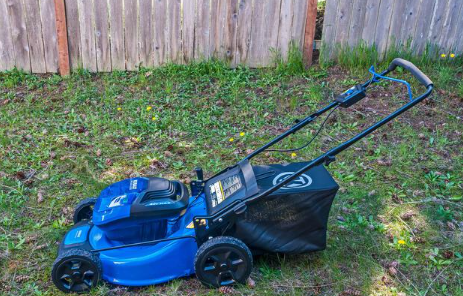
An “appliance” that I did not mention in my first report is our Kobalt electric lawn mower that runs on two Lithium batteries. We have had it for eight years now, and it is fantastic. It is much quieter than a gasoline-powered mower, and you don’t have to mess with gasoline, oil, spark plugs, etc. It starts instantly every time. It does not have as much torque as a gasoline-powered mower, but if you are just mowing ordinary grass it does the job well. It is light and easy for my teenage daughter to use. A few years ago, I bought a third battery because the capacity of the original two batteries had deteriorated.
Our 2016 Tesla Model X has over 100,000 miles on it and is still going strong. The range of the car has decreased from 260 miles to 230 miles, which is about a 12% reduction. Our Chevy Volt was totaled in an accident, and we replaced it with a Tesla Model 3 two years ago. It has about 26,000 miles on it, and the range has decreased from 358 miles to 333 miles, which is about a 7% reduction. Both cars have been driven multiple times to the east coast, and the Model X as far west as Wyoming. It is never a problem to find charging, and the Model 3 charges so fast that it is often ready to depart sooner than we are.
2023 Performance
In 2023, we exported 11,800 kWh to the grid and imported 16,720 kWh, so we were a net importer of 4,920 kWh to power our house and two electric cars. That is a big change from 2017, summarized in my first report, when we were a net exporter of 960 kWh. How can the result be so different?
I believe the biggest contributor to the difference is the degradation of our solar array. As discussed earlier, we have five modules that are not producing at all. There are also several that appear to be producing at two-thirds of their normal capacity, which suggests that one of the three diodes that make up the module is dead. Place on top of that the normal deterioration of solar modules over time, and you have significantly less power produced.
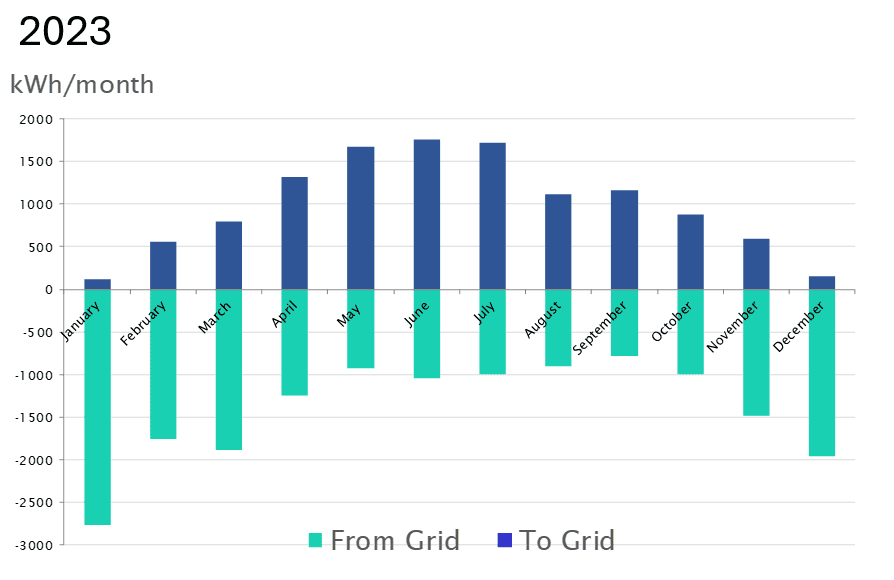
I believe another big contributor is a consequence of the pandemic, in which got my wife accustomed to working from home. She works in the sunroom, which is by far the least well-insulated room in the house, so she uses a resistive heater to keep herself comfortable. January is a month with very little solar electricity production, so our electricity use that month is almost entirely imported. There were about 560 kWh more imported in January 2023 than in January 2017, even though January 2017 was on average 5 degrees colder.
The degradation of the solar array is disappointing. I will continue to try to improve what I can. This requires time and money and is something that an ordinary residential electricity customer doesn’t have to worry about. This is an argument for leasing, rather than buying, your solar panels. Then maintenance becomes the solar installer’s problem, not yours.
The degradation of the solar array lessens its financial benefit. However, there is another important consideration that greatly increases the financial benefit of the solar array: inflation. Over the past eight years, the all-in cost of electricity (excluding fixed costs) in central Illinois has more than doubled, from 7.82 cents/kWh in 2015 to 16.14 cents/kWh in 2023. That corresponds to an average inflation rate of 9.5%/year. So each kWh that I avoid buying from the utility is worth more than twice as much now as it was in 2015.
The Tesla Gateway tells me my solar array produced 16,200 kWh of electricity in 2023. That corresponds to an avoided cost of $2,615. So even though my solar array has experienced degradation, it is still very valuable.
1 Comments
Leave a Comment
You must be logged in to post a comment.






Thanks for the update, Scott! What an interesting story! I appreciate you including the details about the animals and other unexpected quirky issues that came up.